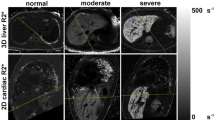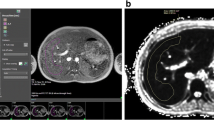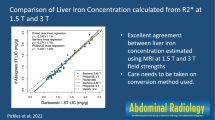Abstract
Purpose
To compare the reproducibility and accuracy of R2-relaxometry MRI for estimation of liver iron concentration (LIC) between in-house analysis and FDA-approved commercially available third party results.
Methods
All MR studies were performed on a 1.5T scanner. Multi-echo spin-echo scans with a fixed TR and increasing TE values of 6 ms, 9 ms, 12 ms, 15 ms, and 18 ms (spaced at 3 ms intervals) were used. Post-processing of the images to calculate mean relaxivity, R2, included drawing of regions of interest to include the whole liver on mid-slice. The relationship between liver R2 values and estimated LIC calculated with in-house analysis and values reported by an external company (FerriScan®, Resonance Health, Australia) were assessed with correlation coefficients and Bland–Altman difference plots. Continuous variables are presented as mean ± standard deviation. Significance was set at p value < 0.05.
Results
474 studies from 175 patients were included in the study (mean age 10.4 ± 4.2 years (range 1–18 years); 254 studies from girls, 220 studies from boys). LIC ranged from 0.6 to 43 mg/g dry tissue, covering a broad range from normal levels to extremely high iron levels. Linearity between proprietary and in-house methods was excellent across the observed range for R2 (31.5 to 334.8 s−1); showing a correlation coefficient of r = 0.87, p < 0.001. Bland–Altman R2 difference plot between the two methods shows a mean bias of + 21.5 s−1 (range − 47.0 to + 90.0 s−1 between two standard deviations). LIC reported by FerriScan® compared with LIC estimated in-house with R2 as reported by FerriScan® agreed strongly, (r = 1.0, p < 0.001).
Conclusion
R2 relaxometry MR imaging for liver iron concentration estimation is reproducible between proprietary FDA-approved commercial software and in-house analysis methods.












Similar content being viewed by others
References
Lieu PT, Heiskala M Fau - Peterson PA, Peterson Pa Fau - Yang Y, Yang Y. The roles of iron in health and disease. (0098-2997 (Print)).
Ware HM, Kwiatkowski JL. Evaluation and treatment of transfusional iron overload in children. Pediatric clinics of North America. 2013;60(6):1393-406.
Regev A, Berho M, Jeffers LJ, Milikowski C, Molina EG, Pyrsopoulos NT, et al. Sampling error and intraobserver variation in liver biopsy in patients with chronic HCV infection. The American journal of gastroenterology. 2002;97(10):2614-8.
Beilby JP, Prins AW, Swanson NR. Determination of hepatic iron concentration in fresh and paraffin-embedded tissue. Clin Chem. 1999;45(4):573-4.
Rockey DC, Caldwell SH, Goodman ZD, Nelson RC, Smith AD. Liver biopsy. Hepatology (Baltimore, Md). 2009;49(3):1017-44.
Cunha GM, Glaser KJ, Bergman A, Luz RP, de Figueiredo EH, Lobo Lopes FPP. Feasibility and agreement of stiffness measurements using gradient-echo and spin-echo MR elastography sequences in unselected patients undergoing liver MRI. The British journal of radiology. 2018;91(1087):20180126.
German AL, Fleming K, Kaye P, Davies S, Goldin R, Hubscher SG, et al. Can reference images improve interobserver agreement in reporting liver fibrosis? Journal of clinical pathology. 2018;71(4):368-71.
Jung ES, Lee K, Yu E, Kang YK, Cho MY, Kim JM, et al. Interobserver Agreement on Pathologic Features of Liver Biopsy Tissue in Patients with Nonalcoholic Fatty Liver Disease. Journal of pathology and translational medicine. 2016;50(3):190-6.
Pournik O, Alavian SM, Ghalichi L, Seifizarei B, Mehrnoush L, Aslani A, et al. Inter-observer and Intra-observer Agreement in Pathological Evaluation of Non-alcoholic Fatty Liver Disease Suspected Liver Biopsies. Hepatitis monthly. 2014;14(1):e15167.
Ratziu V, Bonyhay L, Di Martino V, Charlotte F, Cavallaro L, Sayegh-Tainturier MH, et al. Survival, liver failure, and hepatocellular carcinoma in obesity-related cryptogenic cirrhosis. Hepatology (Baltimore, Md). 2002;35(6):1485-93.
Bedossa P, Dargere D, Paradis V. Sampling variability of liver fibrosis in chronic hepatitis C. Hepatology (Baltimore, Md). 2003;38(6):1449-57.
Cadranel JF, Rufat P, Degos F. Practices of liver biopsy in France: results of a prospective nationwide survey. For the Group of Epidemiology of the French Association for the Study of the Liver (AFEF). Hepatology (Baltimore, Md). 2000;32(3):477-81.
Froehlich F, Lamy O, Fried M, Gonvers JJ. Practice and complications of liver biopsy. Results of a nationwide survey in Switzerland. Dig Dis Sci. 1993;38(8):1480-4.
Perrault J, McGill DB, Ott BJ, Taylor WF. Liver biopsy: complications in 1000 inpatients and outpatients. Gastroenterology. 1978;74(1):103-6.
Bravo AA, Sheth SG, Chopra S. Liver biopsy. N Engl J Med. 2001;344(7):495-500.
Verlhac S, Morel M, Bernaudin F, Bechet S, Jung C, Vasile M. Liver iron overload assessment by MRI R2* relaxometry in highly transfused pediatric patients: an agreement and reproducibility study. Diagnostic and interventional imaging. 2015;96(3):259-64.
St Pierre TG, Clark PR, Chua-Anusorn W. Measurement and mapping of liver iron concentrations using magnetic resonance imaging. Annals of the New York Academy of Sciences. 2005;1054:379-85.
Angelucci E, Giovagnoni A, Valeri G, Paci E, Ripalti M, Muretto P, et al. Limitations of magnetic resonance imaging in measurement of hepatic iron. Blood. 1997;90(12):4736-42.
Brittenham GM, Badman DG. Noninvasive measurement of iron: report of an NIDDK workshop. Blood. 2003;101(1):15-9.
Dixon RM, Styles P, al-Refaie FN, Kemp GJ, Donohue SM, Wonke B, et al. Assessment of hepatic iron overload in thalassemic patients by magnetic resonance spectroscopy. Hepatology (Baltimore, Md). 1994;19(4):904-10.
Engelhardt R, Langkowski JH, Fischer R, Nielsen P, Kooijman H, Heinrich HC, et al. Liver iron quantification: studies in aqueous iron solutions, iron overloaded rats, and patients with hereditary hemochromatosis. Magn Reson Imaging. 1994;12(7):999-1007.
Kaltwasser JP, Gottschalk R, Schalk KP, Hartl W. Non-invasive quantitation of liver iron-overload by magnetic resonance imaging. Br J Haematol. 1990;74(3):360-3.
Mavrogeni SI, Gotsis ED, Markussis V, Tsekos N, Politis C, Vretou E, et al. T2 relaxation time study of iron overload in b-thalassemia. Magma (New York, NY). 1998;6(1):7-12.
Papakonstantinou O, Kostaridou S, Maris T, Gouliamos A, Premetis E, Kouloulias V, et al. Quantification of liver iron overload by T2 quantitative magnetic resonance imaging in thalassemia: impact of chronic hepatitis C on measurements. Journal of pediatric hematology/oncology. 1999;21(2):142-8.
St Pierre TG, Clark PR, Chua-anusorn W, Fleming AJ, Jeffrey GP, Olynyk JK, et al. Noninvasive measurement and imaging of liver iron concentrations using proton magnetic resonance. Blood. 2005;105(2):855-61.
Stark DD, Bass NM, Moss AA, Bacon BR, McKerrow JH, Cann CE, et al. Nuclear magnetic resonance imaging of experimentally induced liver disease. Radiology. 1983;148(3):743-51.
Voskaridou E, Douskou M, Terpos E, Papassotiriou I, Stamoulakatou A, Ourailidis A, et al. Magnetic resonance imaging in the evaluation of iron overload in patients with beta thalassaemia and sickle cell disease. Br J Haematol. 2004;126(5):736-42.
Wang ZJ, Haselgrove JC, Martin MB, Hubbard AM, Li S, Loomes K, et al. Evaluation of iron overload by single voxel MRS measurement of liver T2. J Magn Reson Imaging. 2002;15(4):395-400.
Sirlin CB, Reeder SB. Magnetic resonance imaging quantification of liver iron. Magnetic resonance imaging clinics of North America. 2010;18(3):359-81, ix.
Serai SD, Fleck RJ, Quinn CT, Zhang B, Podberesky DJ. Retrospective comparison of gradient recalled echo R2* and spin-echo R2 magnetic resonance analysis methods for estimating liver iron content in children and adolescents. Pediatric radiology. 2015;45(11):1629-34.
Serai SD, Trout AT, Fleck RJ, Quinn CT, Dillman JR. Measuring liver T2* and cardiac T2* in a single acquisition. Abdom Radiol (NY). 2018.
Towbin AJ, Serai SD, Podberesky DJ. Magnetic resonance imaging of the pediatric liver: imaging of steatosis, iron deposition, and fibrosis. Magn Reson Imaging Clin N Am. 2013;21(4):669-80.
Hankins JS, McCarville MB, Loeffler RB, Smeltzer MP, Onciu M, Hoffer FA, et al. R2* magnetic resonance imaging of the liver in patients with iron overload. Blood. 2009;113(20):4853-5.
Wood JC, Enriquez C, Ghugre N, Tyzka JM, Carson S, Nelson MD, et al. MRI R2 and R2* mapping accurately estimates hepatic iron concentration in transfusion-dependent thalassemia and sickle cell disease patients. Blood. 2005;106(4):1460-5.
Wood JC, Pressel S, Rogers ZR, Odame I, Kwiatkowski JL, Lee MT, et al. Liver iron concentration measurements by MRI in chronically transfused children with sickle cell anemia: baseline results from the TWiTCH trial. Am J Hematol. 2015;90(9):806-10.
St Pierre TG, El-Beshlawy A, Elalfy M, Al Jefri A, Al Zir K, Daar S, et al. Multicenter validation of spin-density projection-assisted R2-MRI for the noninvasive measurement of liver iron concentration. Magn Reson Med. 2014;71(6):2215-23.
Clark PR, Chua-Anusorn W, St Pierre TG. Proton transverse relaxation rate (R2) images of liver tissue; mapping local tissue iron concentrations with MRI [corrected]. Magnetic resonance in medicine. 2003;49(3):572-5.
Clark PR, St Pierre TG. Quantitative mapping of transverse relaxivity (1/T(2)) in hepatic iron overload: a single spin-echo imaging methodology. Magnetic resonance imaging. 2000;18(4):431-8.
Hallgren KA. Computing Inter-Rater Reliability for Observational Data: An Overview and Tutorial. Tutorials in quantitative methods for psychology. 2012;8(1):23-34.
Pirasteh A, Yuan Q, Hernando D, Reeder SB, Pedrosa I, Yokoo T. Inter-method reproducibility of biexponential R2 MR relaxometry for estimation of liver iron concentration. Magnetic resonance in medicine. 2018;80(6):2691-701.
Author information
Authors and Affiliations
Corresponding author
Additional information
Publisher's Note
Springer Nature remains neutral with regard to jurisdictional claims in published maps and institutional affiliations.
Rights and permissions
About this article
Cite this article
Calle-Toro, J.S., Barrera, C.A., Khrichenko, D. et al. R2 relaxometry based MR imaging for estimation of liver iron content: A comparison between two methods. Abdom Radiol 44, 3058–3068 (2019). https://doi.org/10.1007/s00261-019-02074-4
Published:
Issue Date:
DOI: https://doi.org/10.1007/s00261-019-02074-4




